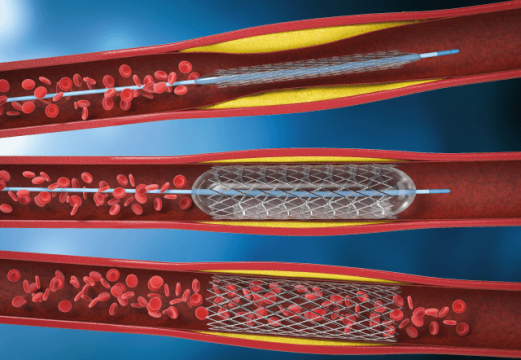In left main coronary artery (LMCA) disease, for lesions of low to intermediate complexity according to the SYNTAX score, percutaneous coronary intervention (PCI) has shown five-year mortality rates comparable to those for to coronary artery bypass grafting (CABG). Compared to ostial or mid-segment lesions, the distal segment of the LMCA presents an interventional challenge due to vessel caliber at the bifurcation, angulation, and the importance of the side branch (SB).

The EBC Main (European Bifurcation Club Left Main) study, a multicenter investigator-initiated trial (including 35 centers in 11 European countries), randomized patients to either provisional stenting or an initial two-stent strategy. At 12 months, there were no significant differences in major adverse cardiac events (MACE) (14.7% vs. 17.7%; P=0.34). The study presented by Arunothayaraj et al. assessed its results at three years.
Researchers included patients with true LMCA bifurcation lesions (Medina 1,1,1 or 0,1,1) and reference vessels ≥2.75 mm, with both chronic and acute coronary syndromes (CCS or ACS). As part of the inclusion criteria, patients had to experience ischemic symptoms, present a positive non-invasive test, positive FFR, or a minimum luminal area <6 mm² by intravascular ultrasound (IVUS). Patients with shock, chronic total occlusion (CTO) of major vessels, trifurcation (vessels ≥2.75 mm), or LMCA with a main diameter ≥5.75 mm were excluded.
In the provisional stenting group, post-kissing balloon inflation (KBI) was not recommended unless TIMI flow was compromised, residual stenosis was ≥90%, or SB dissection was greater than type A. In the two-stent group, operators could choose between the T-stenting, TAP, culotte, or DK-crush strategies.
Lesions were classified as complex according to DEFINITION criteria if they had ostial disease extending ≥10 mm, stenosis ≥70%, and at least two minor criteria (angulation <45° or ≥70°, main vessel ≤2.5 mm, length ≥25 mm, or moderate/severe calcification). Resolute Onyx (zotarolimus) stents were used, and patients received dual antiplatelet therapy for at least six months. Follow-up lasted 36 months, with MACE as the primary endpoint, while secondary endpoints included individual MACE components, angina, thrombosis, and use of antianginal medication.
A total of 467 patients were included, with a mean age of 71 years; 29% had diabetes and 23% were women. One-third of all procedures were performed in a setting of ACS. More than half of the lesions presented moderate to severe calcification, and the reference diameter for the SB (by QCA) was 2.9 mm. Notably, only 1.5% of the cohort met DEFINITION criteria for complexity. The use of intravascular imaging was 39%.
In the provisional stenting group, 22% of patients required SB stenting (T-stenting and TAP). The incidence of MACE was 23.5% in the provisional stenting group vs. 29.5% in the two-stent technique group (hazard ratio [HR] 0.75 [95% confidence interval (CI): 0.52–1.07]; P=0.11). There were no significant differences in all-cause mortality (10.0% vs. 13.1%) or myocardial infarction (12.2% vs. 11.0%). However, the incidence of target lesion revascularization (TLR) was significantly lower in the provisional stenting group (8.3% vs. 15.6%; HR 0.50 [95% CI: 0.29–0.86]; P=0.013).
In subgroups with SB <3.25 mm, the incidence of MACE was higher in the two-stent cohort (HR 2.16 [95% CI: 1.13–4.12]). Conversely, for SB lesions ≥10 mm in length, the provisional stenting group experienced more adverse events (HR 2.74 [95% CI: 1.37–5.45]).
Conclusions
In the three-year follow-up of the EBC Main study, there were no significant differences in MACE between the two strategies, although TLR was lower in the provisional stenting group. It is important to highlight the low complexity of bifurcation lesions in this cohort, as only 1.5% met DEFINITION criteria. Subgroups with SB <3.25 mm and SB disease <10 mm in length were more effectively treated with the provisional stenting strategy.
Original Title: Stepwise Provisional Versus Systematic Dual-Stent Strategies for Treatment of True Left Main Coronary Bifurcation Lesions.
Reference: Arunothayaraj S, Egred M, Banning AP, Brunel P, Ferenc M, Hovasse T, Wlodarczak A, Pan M, Schmitz T, Silvestri M, Erglis A, Kretov E, Lassen JF, Chieffo A, Lefèvre T, Burzotta F, Cockburn J, Darremont O, Stankovic G, Morice MC, Louvard Y, Hildick-Smith D. Stepwise Provisional Versus Systematic Dual-Stent Strategies for Treatment of True Left Main Coronary Bifurcation Lesions. Circulation. 2025 Feb 5. doi: 10.1161/CIRCULATIONAHA.124.071153. Epub ahead of print. PMID: 39907022.
Subscribe to our weekly newsletter
Get the latest scientific articles on interventional cardiology





